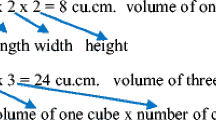Abstract
The purpose of this study was to investigate the effect of cooperative learning and the need for affiliation on performance, time on task, and satisfaction. Subjects used either a cooperative or individual learning strategy while receiving information, examples, practice, and feedback from an instructional television lesson. Results indicated that subjects who worked cooperatively spent more time working on practice exercises and reported greater satisfaction than those who worked individually. In addition, results revealed an interaction between instructional method and the need for affiliation. Performance of subjects with a high need for affiliation who worked alone was lower than that of all other groups when subjects were asked to apply what they had learned from the lesson. Implications for employing cooperative groups in settings that were originally designed for individual learning are provided.
Similar content being viewed by others
References
Adams, D., Carson, H., & Hamm, M. (1990).Cooperative learning and educational media. Englewood Cliffs, NJ: Educational Technology Publications.
Carrier, C. A., & Sales, G. C. (1987). Pair versus individual work on the acquisition of concepts in a computer-based instructional lesson.Journal of Computer-Based Instruction, 14, 11–17.
Cohen, J. (1969).Statistical power analyses for the behavioral sciences. New York: John Wiley.
Dalton, D. W., Hannafin, M. J., & Hooper, S. (1989). Effects of individual and cooperative computer-assisted instruction on student performance and attitude.Educational Technology Research & Development, 37(2), 15–24.
Ferguson, G. A. (1981).Statistical analysis in psychology and education (5th ed.). New York: McGraw-Hill.
Gerlach, V. (1973).Instructional theory: A nine unit mini-course. Lincoln, NE: Nebraska Educational Television Council for Higher Education.
Hooper, S., & Hannafin, M. J. (1991). The effects of group composition on achievement, interaction, and learning efficiency during computer-based cooperative instruction.Educational Technology Research & Development, 39(3), 27–40.
Jackson, D. N. (1974).Personality research form manual. Goshen, NY: Research Psychologists Press.
Johnson, D. W., & Johnson, R. T. (1989).Cooperation and competition: Theory and research. Edina, MN: Interaction Book Company.
Johnson, R. T., Johnson, D. W., & Stanne, M. (1985). Effects of cooperative, competitive, and individualistic goal structures on computer-assisted instruction.Journal of Educational Psychology, 77, 668–677.
Keller, J. M. (1983). Motivational design of instruction. In C. M. Reigeluth (Ed.),Instructional-design theories and models: An overview of their current status (pp. 386–434). Hillsdale, NJ: Lawrence Erlbaum.
Keller, J. M. (1987).Instructional materials motivation scale (IMMS). Unpublished manuscript, Florida State University, Tallahassee.
McClelland, D. C. (1965). Toward a theory of motive acquisition.American Psychologist, 20, 321–333.
McClelland, D. C. (1976).The achieving society. New York: Irvington.
Rysavy, D. M., & Sales, G. C. (1991). Cooperative learning in computer-based instruction.Educational Technology Research & Development, 39(2), 70–79.
Sharan, S. (1980). Cooperative learning in small groups: Recent methods and effects on achievement, attitudes, and ethnic relations.Review of Educational Research, 50, 241–272.
Slavin, R. E. (1990).Cooperative learning: Theory, research, and practice. Englewood Cliffs, NJ: Prentice Hall.
Sutter, E. G., & Reid, J. B. (1969). Learner variables and interpersonal conditions in computer-assisted instruction.Journal of Educational Psychology, 60, 153–157.
Webb, N. M. (1982). Peer interaction and learning in small cooperative groups.Journal of Educational Psychology, 74, 642–655.
Webb, N. M. (1989). Peer interaction and learning in small groups.International Journal of Educational Research, 13(1), 21–39.
Author information
Authors and Affiliations
Rights and permissions
About this article
Cite this article
Klein, J.D., Pridemore, D.R. Effects of cooperative learning and need for affiliation on performance, time on task, and satisfaction. ETR&D 40, 39–48 (1992). https://doi.org/10.1007/BF02296898
Issue Date:
DOI: https://doi.org/10.1007/BF02296898




